
How To Build A Racing Simulator - A Comprehensive Guide
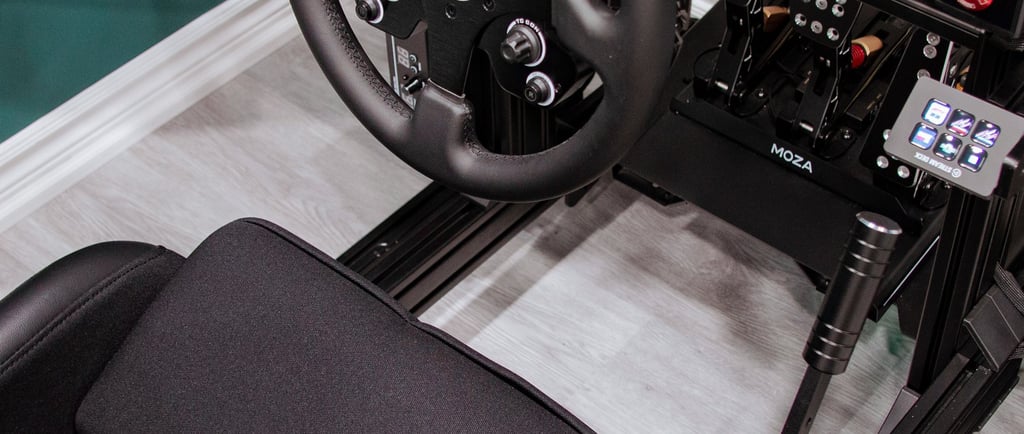

Introduction: A racing simulator offers an immersive motorsport experience at home, enhancing driving skills and enjoyment.
Essential Components:
Chassis/Rig: Choose between pre-built or DIY options.
Seat: Opt for a comfortable, adjustable racing-style seat.
Display: Select a monitor setup (single, triple, or VR) for optimal visuals.
Steering Wheel & Pedals: Invest in quality force feedback systems.
Optional Motion System: Adds realism with physical movement.
Building Your Simulator: Assemble the chassis, install the seat and display, mount the steering wheel and pedals, and manage cables for a clean setup.
Software and Games: Choose popular sim racing titles, configure settings, and calibrate controls for an optimal experience.
Accessories: Enhance your setup with shifters, button boxes, motion systems, and VR integration.
Optimizing Setup: Focus on ergonomics, fine-tune force feedback and pedal settings, and ensure performance optimization.
Maintenance and Upgrades: Regularly clean components, monitor performance, and plan for future upgrades to keep your simulator in top shape.
Budget Considerations: Determine costs for entry-level ($500-$1,000), mid-range ($1,000-$5,000), and high-end ($5,000+) setups.
Conclusion: A well-built racing simulator provides an engaging way to enjoy racing from home; start building your dream setup today!
Key Takeaways


A racing simulator is more than just a gaming setup—it's an immersive experience that brings the excitement of motorsports directly into your home. Unlike traditional gaming, a well-constructed racing simulator provides near-realistic driving dynamics, allowing enthusiasts to experience the thrill of racing without leaving their living room.



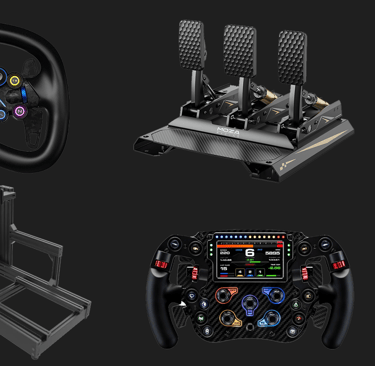
Essential Components
How To Build A Racing Simulator
Realistic physics and feedback
Customizable to your preferences
Upgradeable over time
Suitable for various skill levels
Connects you with a global racing community
Building a racing simulator is an exciting journey that combines technology, passion, and the pure joy of motorsports. Whether you're a casual gamer or an aspiring professional driver, a custom racing simulator offers an unparalleled way to experience the world of high-speed racing. Sim racing is great for; an authentic racing experience, improving driving skills, practicing motorsport techniques, enjoying competitive online racing and a cost-effective alternative to real-world racing allow the user to experience all sorts of racing styles, vehicles and tracks.
Why Build a Racing Simulator?

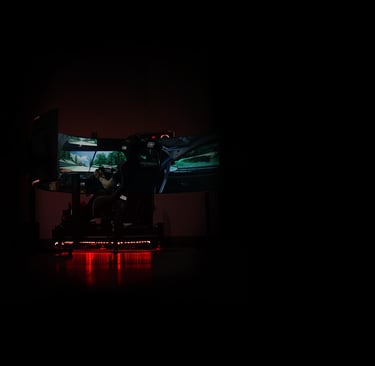
Key Benefits
This Guide Provides A Step-By-Step Approach To Building Your Own Racing Simulator, Perfect For Beginners And Enthusiasts Alike. Learn How To Choose Essential Components Like The Sim Racing Chassis, Racing Seat, Steering Wheel, Pedals & Accessories To Create An Immersive Racing Experience At Home. Discover Tips On Optimizing Your Setup For Realism, Ensuring Compatibility With Gaming Platforms, And Maintaining Your Equipment.
Chassis (aka. Rig)
Single Monitor
A single monitor setup is a popular choice for many sim racers due to its simplicity and cost-effectiveness. It offers a focused view of the racing action and requires less processing power compared to multi-monitor setups. High-resolution 4K monitors with large screen sizes (32" or more) can provide an immersive experience while maintaining a clean, uncluttered setup
Triple Monitor Setup
Triple monitor setups offer a wider field of view, enhancing peripheral vision and immersion. This configuration allows
racers to see more of the track and nearby competitors, potentially improving lap times and race
awareness. However, triple monitor setups require more space, higher GPU power, and can be more
complex to set up and calibrate properly
Ultrawide Monitor
Ultrawide monitors provide a middle ground between single and triple monitor setups. They offer an expanded
field of view without the bezels of a triple monitor configuration. Ultrawide monitors can deliver a more immersive
experience than standard single monitors while being more space-efficient and easier to set up than triple monitor arrays
VR Headset Options
Virtual Reality (VR) headsets offer the most immersive sim racing experience, providing a 360-degree view
of the virtual cockpit and track. VR allows for natural head movements and depth perception, enhancing
the realism of the racing experience. However, VR can be more physically demanding and may cause
discomfort during extended use for some users. It also requires significant computing power to
run smoothly
Mounting Solutions
Proper mounting is crucial for any display setup in sim racing. Options include:
Monitor Arms: Adjustable arms allow for flexible positioning of single or multiple monitors, saving desk space and improving ergonomics.
Integrated Mounts: Some sim rigs come with built-in monitor stands, providing a stable and adjustable platform for displays.
Wall Mounts: For permanent setups, wall-mounting monitors can create a clean look and save floor space.
VR Mounts: Dedicated VR headset mounts keep the device secure and easily accessible when not in use.
Choosing the right mounting solution depends on your specific setup, available space, and personal preferences. Proper mounting ensures optimal viewing angles and stability during intense racing sessions
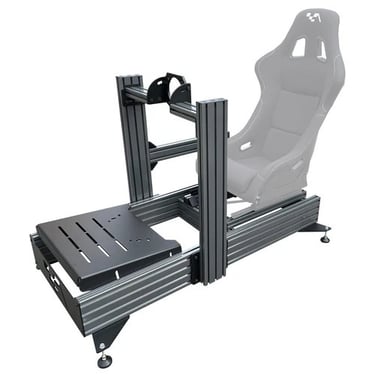

Provides structural foundation
Options: aluminum profile, metal, wooden frame
Must support weight and withstand racing forces
Adjustable for different body types
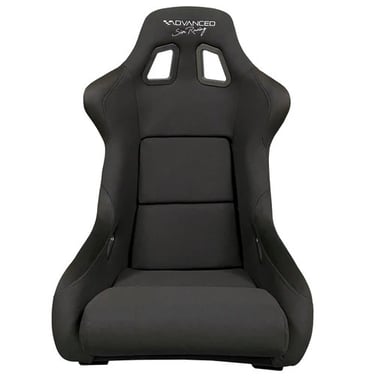

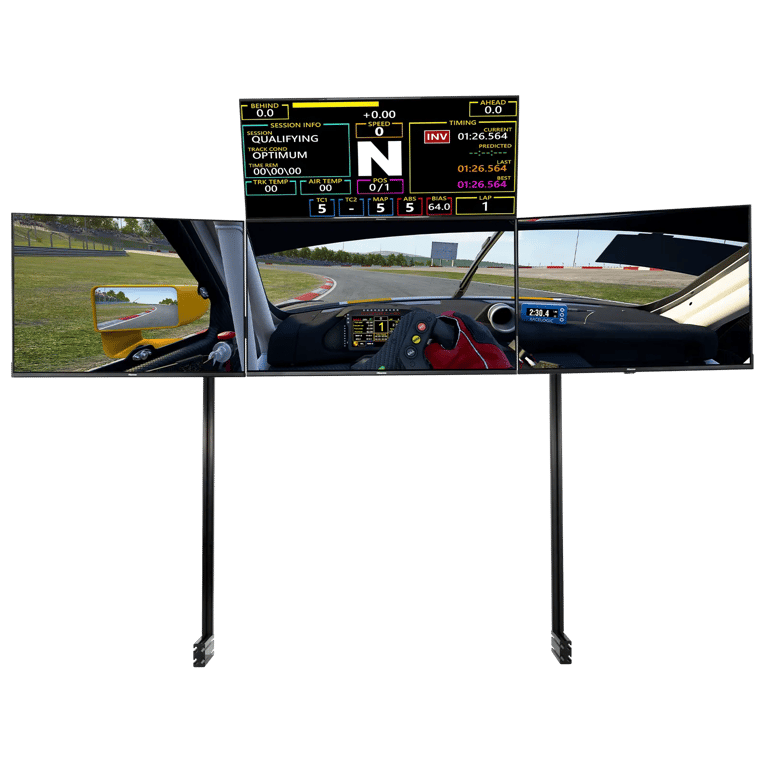

Monitor & Display Options
Seat
A sim racing chassis, also known as a rig, is the foundational structure that supports all other components of a sim racing setup. It is crucial for ensuring stability and enhancing the overall racing experience.
Materials and Construction
Aluminium Profile (8020):
Versatility and Strength: Aluminium profile rigs are highly regarded for their strength and versatility. The 8020 design allows for extensive customization, enabling users to mount various components like keyboards, handbrakes, or shifters directly onto the structure using universal mounting adapters
Rigidity: This material is particularly effective in eliminating flex, which is the unwanted movement of parts under high loads such as braking or steering with force feedback wheels
Metal Tubes or Frames:
These rigs offer similar strength to aluminium profiles but with different aesthetic and structural designs. They can provide a more integrated look and are often more visually appealing
Design Considerations
Stability and Rigidity:
A key feature of any good sim rig is its ability to remain stable under the forces generated by high-powered direct drive wheels and pedals. Rigidity prevents flexing, which can affect performance and immersion by introducing unwanted movements during intense racing sessions
Mounting Options:
Most rigs come with pre-drilled mounting plates for easy installation of various components. Ensuring compatibility between your rig's mounting points and your equipment is essential to avoid additional modifications
Adjustability:
A good rig should offer plenty of adjustability to accommodate different user preferences and body types. This includes adjustable seating positions, pedal placements, and wheel mounts to ensure ergonomic comfort during extended use
Additional Features
Monitor Stands: Some rigs include integrated monitor stands, which can enhance immersion by positioning screens at optimal viewing angles
Pedal Bases and Wheel Mounts: These are critical components that need to be compatible with your chosen pedals and wheelbase to ensure secure attachment and optimal performance
In summary, selecting the right chassis or rig involves considering factors such as material strength, rigidity, adjustability, and compatibility with other sim racing components. An aluminium profile rig generally offers the best combination of these features, making it a popular choice among serious sim racers.
How To Build A Racing Simulator
A Comprehensive Guide
The seat is a crucial component of any sim racing setup, as it directly impacts comfort and immersion during long racing sessions
Bucket Seats:
Authenticity: Bucket seats are designed to mimic real motorsport seats, providing an authentic racing experience. They often feature high sides to support the driver during high-speed cornering.
Materials: Typically made from durable materials like synthetic leather or fabric, bucket seats are built to withstand long hours of use.
Reclining Seats:
Adjustability: These seats offer the flexibility to adjust the backrest angle, allowing users to switch between different driving styles, such as GT or Formula positions
Comfort: Reclining seats generally provide more comfort for extended sessions due to their adjustable nature.
Types of Seats
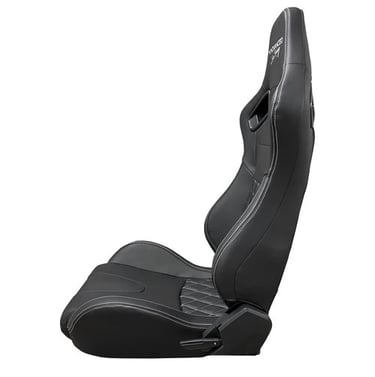

Comfort and Ergonomics:
A comfortable seat is essential for maintaining focus and performance during long races. Look for seats with ample padding and ergonomic design to support your posture
Adjustability:
The ability to adjust the seat position, height, and angle is crucial for finding the optimal driving position. This also includes compatibility with seat sliders, which allow for easy forward and backward adjustments
Mounting Options:
Ensure that the seat can be securely mounted to your rig or chassis. Some rigs come with pre-installed seat mounts, while others may require additional brackets or adapters
Compatibility with Rig:
Check that the seat is compatible with your chosen rig in terms of mounting points and dimensions. Some rigs are sold as a complete package with a seat included, while others require purchasing the seat separately
Space and Budget: The choice of seat may depend on available space and budget constraints. Foldable options like the GT Lite Pro offer a compact solution that can be stored away when not in use
Material Quality: Higher-quality materials will ensure durability and longevity, especially if you plan on using the setup frequently.
In conclusion, selecting the right seat is about balancing comfort, adjustability, and compatibility with your overall sim racing setup. Investing in a quality seat can significantly enhance your racing experience by providing the necessary support and comfort for long sessions.
Considerations
Key Features

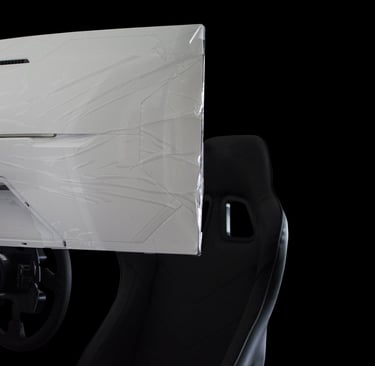
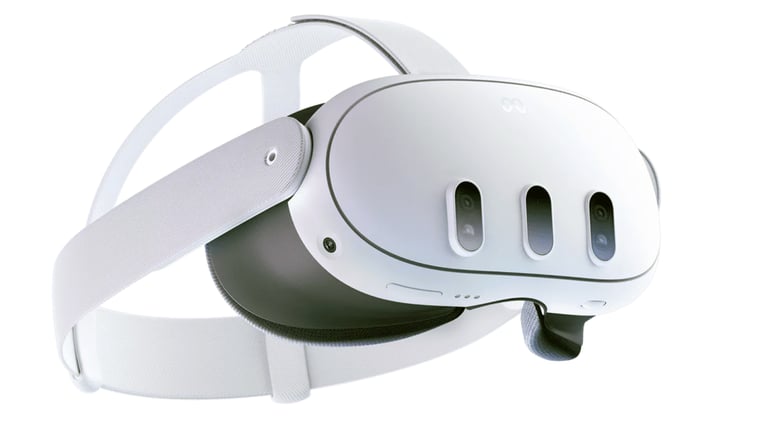



Steering Wheel & Base
Steering Wheel Base
The steering wheel base, also known as the wheelbase, is the device that translates the simulated forces from the
software into Force Feedback (FFB) that you feel through the wheel. There are several types of
wheelbases available:
Direct Drive: These high-end wheelbases offer the most realistic and powerful force feedback.
They can produce up to 30Nm of torque, providing incredibly detailed and responsive feedback4.
Belt-Driven: A mid-range option that offers good force feedback at a more affordable price point.
Gear-Driven: Often found in entry-level wheels, these provide basic force feedback but lack the detail and strength of more advanced systems.
Steering Wheel
The steering wheel itself can often be detached from the base, allowing for customization and swapping between different wheel types. Key features to consider include:
Diameter: Ranging from small Formula-style wheels to larger GT-style wheels.
Button Layout: Look for wheels with easily accessible buttons and switches for in-game controls.
Materials: Higher-end wheels often feature leather or Alcantara grips for improved comfort and durability.
Compatibility and Mounting
When choosing a steering wheel and base, consider:
Compatibility with your chosen sim rig: Ensure the mounting points on your wheelbase match those on your rig1.
Front-mounted vs. side-mounted options: High-end rigs often offer a choice, which can affect the wheel's position and feel1.
Quick Release (QR) System: This allows for easy swapping between different wheel rims3.
Remember, the choice of steering wheel and base will greatly impact your sim racing experience. While budget options can provide a good starting point, more advanced systems offer increased realism and precision for serious sim racers.
The steering wheel and base are crucial components of any sim racing setup, providing the primary interface between the driver and the virtual car
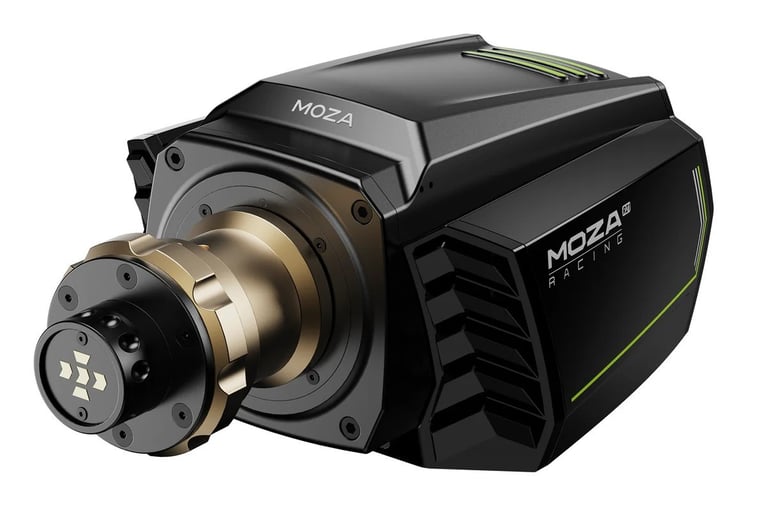

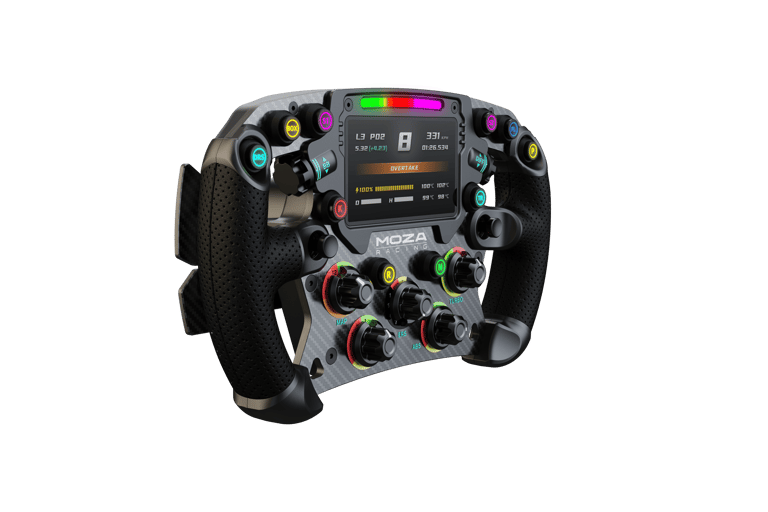

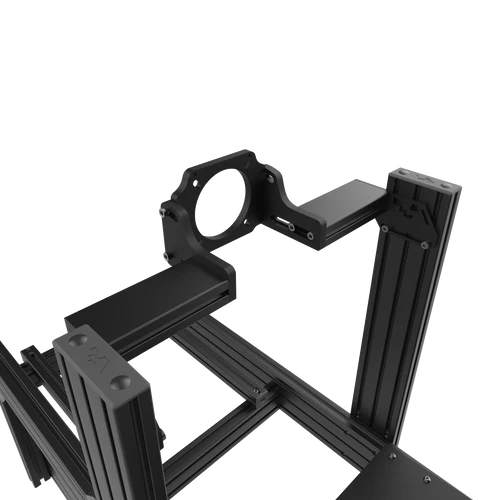


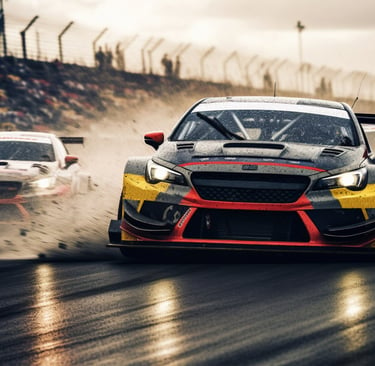
Pedal Set
Pedals are a critical component of any sim racing setup, providing the primary interface for acceleration, braking, and clutch control
Types of Pedals
Entry-Level Pedals:
Often made with plastic and basic potentiometer sensors
Provide minimal feedback and precision
Suitable for beginners on a budget
Load Cell Pedals:
Measure brake pressure instead of travel distance
Offer more realistic braking feel
Provide significantly improved precision and consistency
High-End Pedal Features
Key Characteristics:
Load Cell Sensors: High-end pedals feature advanced load cell technology, with some brake pedals supporting up to 200kg of pressure.
Adjustability: Premium pedals offer extensive customization options
Materials: Constructed from high-quality materials like anodized aluminum
Compatibility Considerations
When selecting pedals, ensure:
Compatibility with your sim racing rig
Mounting options match your chassis
Potential for future upgrades
Notable Pedal Sets
Heusinkveld Sprint:
Known for its professional-grade performance and build quality.
Features a highly adjustable brake pedal with a load cell sensor that offers excellent feedback and precision.
Ideal for serious sim racers looking for a competitive edge.
Moza CRP2:
Crafted from CNC aerospace-grade aluminum with a carbon fiber heel plate, the CRP2 pedals provide unmatched precision and durability.
Equipped with a 200kg load cell sensor and a 15-bit high-precision angle sensor, offering extensive customization options (up to 1,764 configurations).
Designed for serious sim racers, these pedals support inverted mounting and are fully compatible with PC and Xbox systems.
Simagic P1000:
Features a robust construction with an adjustable load cell brake pedal that mimics the feel of real-world braking systems.
Offers customizable pedal travel and resistance settings to suit individual preferences.
Designed for both casual gamers and competitive racers, providing a versatile option for all skill levels.
The right pedal set can dramatically improve your sim racing experience, providing more realistic feedback and precision in your racing performance.
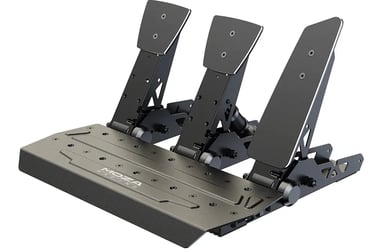


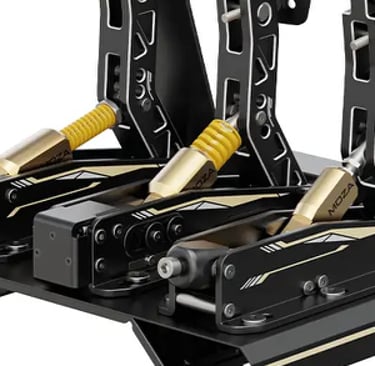
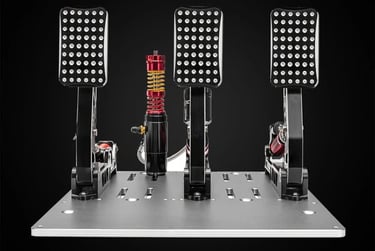


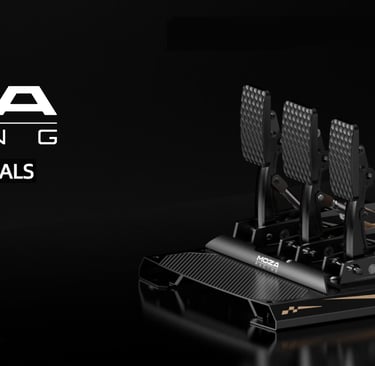
A motion system is an advanced component of a sim racing setup that significantly enhances immersion by replicating the physical sensations of driving. These systems simulate the forces experienced in real-world racing, such as acceleration, braking, cornering, and road texture, providing a more realistic and engaging experience.
Motion System
Key Features of Motion Systems
Degrees of Freedom (DOF): Motion systems can range from 2DOF (pitch and roll) to 6DOF (pitch, roll, yaw, heave, surge, and sway), with more DOF offering a more comprehensive simulation of movement.
Actuator Types: Systems may use electric, hydraulic, or pneumatic actuators, each with its own characteristics in terms of speed, strength, and smoothness.
Response Time: High-quality systems offer minimal latency, ensuring that motion cues are synchronized with visual and audio feedback.
Customizability: Many systems allow users to adjust intensity and response curves to suit individual preferences and different racing games.
Benefits of Motion Systems
Enhanced realism and immersion
Improved spatial awareness in the virtual environment
Better understanding of vehicle dynamics and behavior
Potential for faster lap times due to more intuitive feedback
Notable Option: eRacing Lab RS Mega
The eRacing Lab RS Mega is a standout choice in the motion system market:
Design: A robust 3-6DOF system offering a full range of motion simulation.
Performance: Known for its quick response times and smooth operation.
Compatibility: Works with a wide range of sim racing software and hardware.
Customization: Offers extensive tuning options to tailor the experience to individual preferences.
Build Quality: Constructed with high-quality components for durability and reliability.
Considerations
While motion systems can greatly enhance the sim racing experience, they are a significant investment in terms of cost and space. Users should consider their budget, available space, and commitment to sim racing before investing in a motion system.
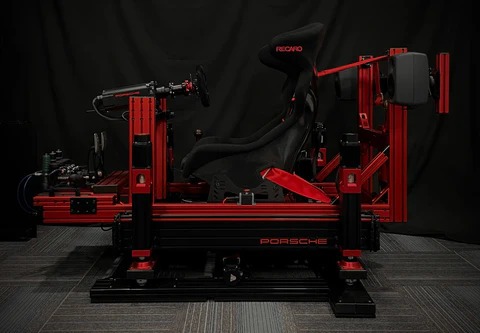

Building Your Simulator

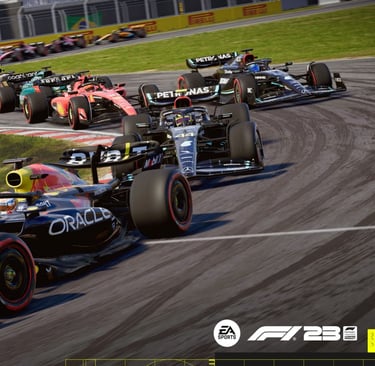
B. Installing the Seat
Align seat mounting points
Use appropriate mounting hardware
Adjust seat position for ergonomic comfort
Ensure proper angle and height
E. Positioning Pedals
Secure pedal set to chassis
Adjust distance from seat
Align for natural foot placement
Test pedal movement and resistance
C. Mounting Display System
Select appropriate monitor mount
Align monitors for optimal viewing angle
Secure mounts to chassis
Cable management for clean setup
F. Cable Management
Use cable ties and clips
Route cables neatly
Prevent tangling or strain
Ensure easy access for maintenance
A. Setting Up the Chassis
Choose a flat, stable surface
Assemble frame according to manufacturer instructions
Ensure all connections are secure
Level the base for proper alignment
D. Attaching Steering Wheel and Base
Mount wheel base to chassis
Ensure sturdy, vibration-free connection
Connect all necessary cables
Calibrate wheel alignment
Pro Tip: Take your time during assembly, double-check all connections, and prioritize stability and comfort.


Optimizing Your Setup
Ergonomics and Comfort
Seat Positioning
Align with natural driving posture
Adjust for proper leg and arm reach
Wheel and Pedal Placement
Minimize strain
Ensure comfortable reach
Prevent fatigue during long sessions
Performance Optimization
PC Settings
System Requirements
Check minimum PC specifications
Ensure graphics card compatibility
Verify RAM and processor requirements
Update graphics drivers
Optimize game settings
Ensure smooth frame rates
Network Configuration
Minimize latency
Optimize internet connection for online racing
Fine-Tuning Force Feedback
Wheel Settings
Adjust strength
Configure sensitivity
Balance realism and comfort
Software Calibration
Use in-game calibration tools
Test different feedback profiles
Personal Customization
Create custom control profiles
Experiment with different settings
Continuously refine your setup
Pedal Calibration
Brake Pressure
Set realistic resistance
Simulate real-world brake feel
Sensitivity Adjustment
Configure throttle and clutch response
Match personal driving style
View Our Download Center To Find Your Sim Racing Software

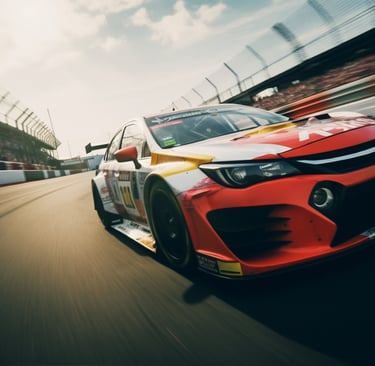
Maintenance & Upgrades
Regular Cleaning
Dust Removal
Use compressed air to clean components monthly
Focus on fans, cooling systems, and electronic connections
Surface Cleaning
Wipe down the chassis and seat with appropriate cleaners
Keep monitors free of smudges
Troubleshooting Issues
Address Performance Drops
Recalibrate controls if necessary
Check for software conflicts or background processes
Seek Community Support
Join forums or groups for advice and solutions
Monitoring Performance
Check System Temperatures
Use software like HWMonitor to track CPU and GPU temps
Ensure proper cooling and airflow
Update Software Regularly
Keep operating system and drivers up to date
Update sim racing titles for the latest features and fixes
Upgrading Components
Identify Bottlenecks
Monitor performance metrics during gameplay
Upgrade hardware as needed (e.g., GPU, RAM)
Plan for Future Enhancements
Consider adding motion systems or advanced peripherals
Stay informed about new technology in sim racing
Regular maintenance and timely upgrades will ensure your racing simulator remains in top condition, providing an optimal racing experience for years to come.
Optimization is an ongoing process – keep experimenting to find your perfect racing experience.
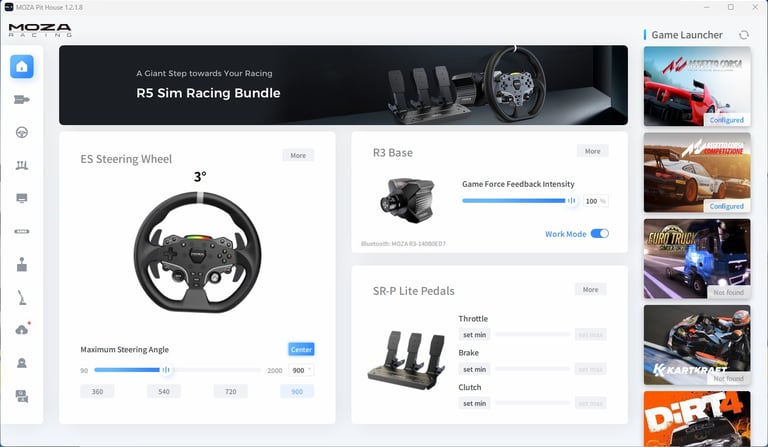


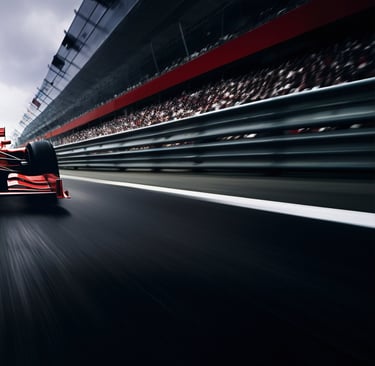
Budget Considerations for Building a Racing Simulator
When embarking on the journey to create your own racing simulator, it's essential to consider your budget carefully. The cost of a sim racing setup can vary widely depending on the level of realism and immersion you desire. Here’s a detailed guide to help you understand the different budget tiers and what you can expect at each level.
Entry-Level Setups
($800 - $2,000)
For those new to sim racing or operating on a limited budget, entry-level setups offer a great starting point. These setups are designed to provide a basic yet enjoyable racing experience without breaking the bank.
Basic Chassis and Seat: Affordable options are available for beginners, offering a simple framework to mount your steering wheel and pedals.
Steering Wheel and Pedals: Entry-level models such as the Logitech G29 provide decent force feedback and pedal response, making them popular choices for newcomers.
Single Monitor: A cost-effective display solution, a single monitor setup offers sufficient immersion for casual racing enthusiasts.
Additional Costs to Consider
Beyond the core components, there are additional expenses that may arise:
Software Licenses: Consider the cost of sim racing titles and any subscription services required (e.g., iRacing).
Accessories and Upgrades: Items like shifters, button boxes, and other enhancements can improve your setup but add to the overall cost.
Mid-Range Options
($2,000 - $5,000)
Mid-range setups cater to those looking for enhanced performance and immersion. These setups strike a balance between affordability and quality.
Improved Chassis: Expect sturdier construction with better adjustability, allowing for more comfortable and ergonomic positioning.
Quality Steering Wheel and Pedals: Mid-tier options like the Thrustmaster T300 offer improved force feedback and pedal precision, elevating the driving experience.
Triple Monitor Setup: Provides an enhanced field of view, increasing immersion by surrounding you with the virtual environment.
Budgeting Tips
To make the most of your investment:
Prioritize Essential Components First: Focus on acquiring quality core components before expanding with accessories.
Research Deals and Second-Hand Options: Look for sales or consider purchasing used equipment to save money.
Plan for Gradual Upgrades Over Time: Start with a solid foundation and upgrade components as your budget allows.
High-End Professional Rigs
($5,000+)
For serious racers seeking the ultimate in realism and performance, high-end rigs offer top-of-the-line components and features.
Premium Chassis and Seat: Custom-built or high-quality pre-built rigs provide exceptional stability and comfort.
Direct Drive Wheel and Advanced Pedals: High-performance systems, such as those from Fanatec Podium, deliver unparalleled force feedback and precision.
Motion Systems and VR Integration: Incorporating full motion platforms and virtual reality can offer the most realistic racing experience possible.


Building a racing simulator is an exciting project that combines technology, passion, and the thrill of motorsports. By carefully selecting components, optimizing your setup, and maintaining your equipment, you can create an immersive racing experience tailored to your preferences.
Just remember;
Essential Components: Focus on the chassis, seat, steering wheel, pedals, and display system.
Customization: Personalize your setup with accessories and enhancements for greater realism.
Ongoing Maintenance: Regular cleaning and upgrades will keep your simulator performing at its best.
Budget Planning: Consider your budget at each stage to ensure a balanced investment.
Whether you’re a casual gamer or an aspiring racer, a well-built simulator can provide countless hours of enjoyment and skill development. Start your journey today and experience the excitement of racing from the comfort of your home. Reach out to a Dark Horse SimRacing team member today to get started!
